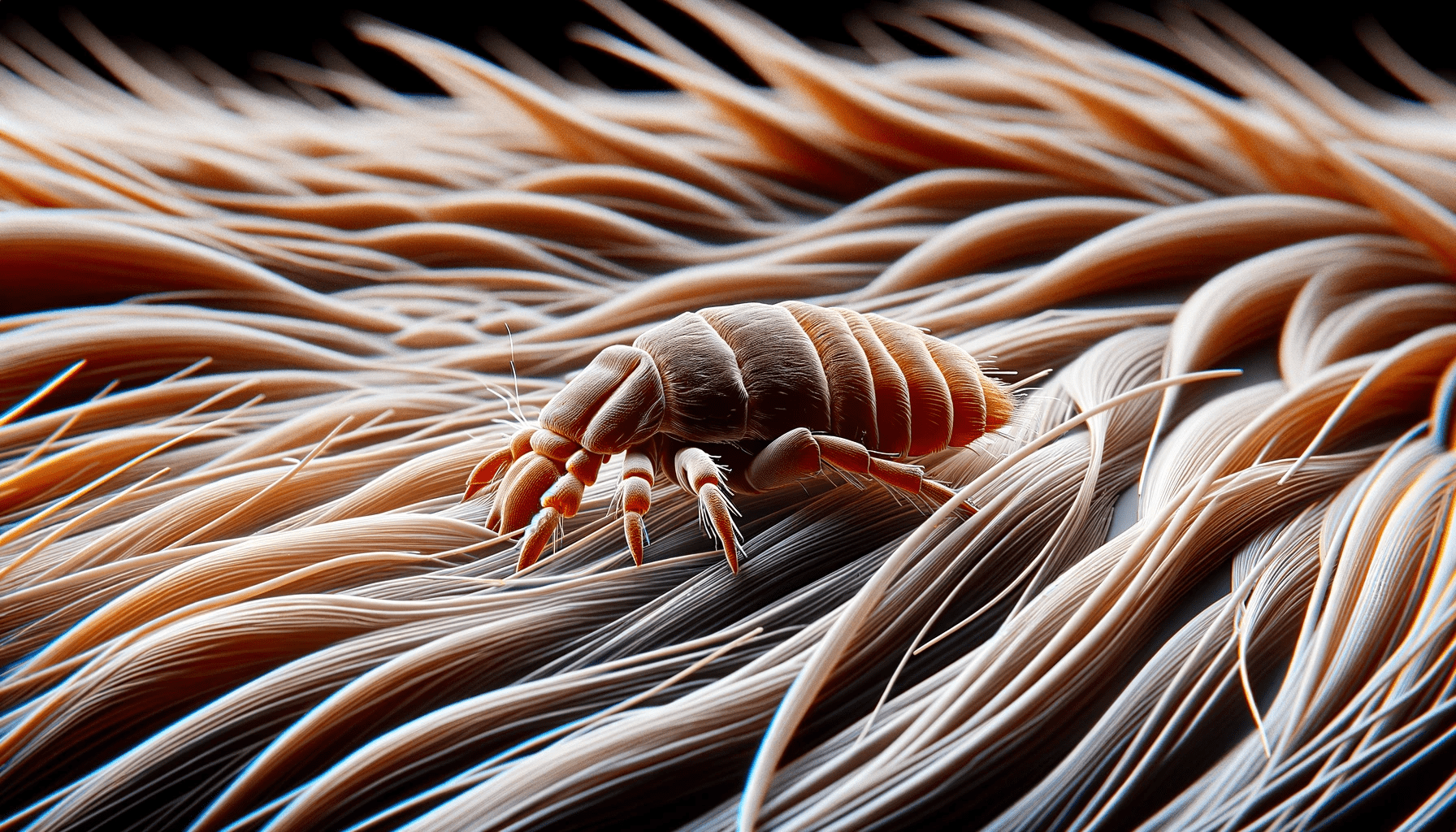Do you want to know what ear mites look like in your dog’s ear? Well, they’re tiny little creatures, about 1-2 millimeters long, and they kind of resemble fat ticks with short legs. You won’t be able to spot them with your naked eye, but if you use a magnifying lens, you’ll see these little white specks moving around.
Veterinarians have special tools, like microscopes and otoscopes, to easily see them. They can also take a sample of your dog’s ear debris and examine it to confirm if it’s ear mites.
So, if your furry friend is shaking their head, scratching a lot, or has dark discharge or coffee ground-like debris in their ears, it’s time to see the vet for proper diagnosis and treatment.
Key Takeaways
- Ear mites are tiny parasites that resemble fat ticks and are difficult to see with the naked eye.
- Symptoms of ear mites include skin irritation, redness around the ears, frequent scratching, head shaking, dark and waxy discharge, and unpleasant odor from the ears.
- Proper diagnosis by a veterinarian is important to distinguish ear mites from other ear conditions.
- Treatment options for ear mites include thorough cleaning of the ears, prescription ear drops, and oral medications, which should be followed according to the vet’s instructions.
Understanding Ear Mites
To understand ear mites, you need to familiarize yourself with their appearance and behavior. Ear mites are tiny parasites that infest the ears of dogs. They’re barely visible to the naked eye, measuring only 1-2 millimeters in length. Due to their small size, they can be difficult to spot without magnification. Under a microscope, ear mites appear as tiny, white moving specks, resembling fat ticks with short legs.
When ear mites infest a dog’s ear, they can cause a range of symptoms. These include skin irritation, head shaking, scratching around the ears, and the presence of dark and waxy ear discharge. If you notice any of these signs in your dog, it’s important to consult a veterinarian for proper diagnosis and treatment.
Treating ear mites in dogs typically involves thorough cleaning of the ears and the use of prescription ear drops or medications. Some commonly prescribed medications for ear mites include Revolution, Advantage Multi, Simparica, and Bravecto.
Prevention and control of ear mites in dogs can be achieved through regular ear cleaning, avoiding contact with infested animals, and maintaining a clean living environment. By staying vigilant and taking appropriate measures, you can help protect your dog from the discomfort and complications associated with ear mites.
Identifying Ear Mite Symptoms
If you suspect your dog has ear mites, look for signs such as skin irritation, redness, scratching, head shaking, and a dark, waxy discharge resembling coffee grounds. These symptoms are common indicators of ear mites in dogs.
Dogs with ear mites often experience skin irritation and redness in and around their ears. They may scratch at their ears, head, and neck frequently, as well as shake their heads to alleviate the discomfort. Another telltale sign of ear mites is the presence of a dark and waxy discharge in the ear canal. This discharge resembles coffee grounds and may have an unpleasant odor.
If you observe these symptoms in your dog, it’s important to seek veterinary attention promptly. While ear mites are barely visible to the naked eye, they can be observed as tiny, white moving specks under magnification. They resemble fat ticks with short legs.
Identifying these symptoms and seeking treatment for your dog is crucial in order to alleviate their discomfort and prevent further complications.
Examining Ear Mite Appearance
When examining the appearance of ear mites, it’s important to note that they’re tiny and difficult to see with the naked eye. These mites resemble fat ticks with short legs and appear as tiny, white moving specks under magnification.
Veterinarians often use a microscope or otoscope to detect their presence.
Identifying Common Symptoms
Take a close look at your dog’s ear to identify the appearance of ear mites. Although ear mites are barely visible to the naked eye, they can be seen as tiny white moving specks under magnification. When magnified, they resemble fat ticks with short legs.
If you suspect your dog has ear mites, it’s best to consult a veterinarian who can easily detect them using a microscope or otoscope. One of the common symptoms of ear mites is an unpleasant odor emanating from the ears. Additionally, you may notice a dark discharge resembling coffee grounds in your dog’s ears.
These symptoms can indicate the presence of ear mites and should be examined by a veterinarian for proper diagnosis and treatment.
Treatment Options Available
To properly address the issue of ear mite appearance and treatment options, it’s essential to consult a veterinarian who can accurately diagnose and prescribe the most suitable course of action.
Once your dog has been examined, the vet will be able to confirm whether or not your dog has ear mites. If a diagnosis of ear mites is made, there are several treatment options available.
Thorough cleaning of the ears is usually the first step in treating ear mites. This may involve removing any debris or discharge from the ears.
Prescription ear drops, such as Revolution or Advantage Multi, may also be recommended to kill the mites and alleviate any discomfort. In some cases, oral medications like Simparica or Bravecto may be prescribed.
The vet will determine the most appropriate treatment option for your dog based on their specific needs. It’s important to follow the vet’s instructions carefully to ensure successful treatment and prevent any recurrence of the infestation.
How Dogs Get Ear Mites
If your dog spends time with other infested dogs or cats, they may be at risk of contracting ear mites. Ear mites are tiny parasites that infest the ears of dogs, causing irritation and discomfort. These mites are highly contagious and can easily spread from one animal to another. Dogs can get ear mites through direct contact with infested animals, such as playing, grooming, or sleeping together. Sharing bedding or living in close quarters with an infested animal can also increase the risk of transmission.
Ear mite infestations are more common in puppies than in older dogs, as their immune systems aren’t fully developed. However, dogs of all ages can get ear mites if they come into contact with an infested animal. It’s important for dog owners to be vigilant and look for signs of ear mites in their pets, such as excessive scratching or shaking of the head, dark discharge from the ears, and a strong odor.
If you suspect that your dog has ear mites, it’s important to seek veterinary care for proper diagnosis and treatment. Prompt treatment can help alleviate your dog’s discomfort and prevent the spread of ear mites to other animals.
Diagnosing Ear Mites in Dogs
To properly diagnose ear mites in your dog, a veterinarian will examine your dog’s ears using specialized equipment. Ear mites are tiny parasites that are difficult to see with the naked eye. Therefore, veterinarians use tools such as a microscope or otoscope to get a closer look. By magnifying the area, the vet can easily identify the presence of ear mites.
These mites appear as tiny, white moving specks, resembling fat ticks with short legs. They’re typically found in the ear canal, where they feed on wax and oils. In some cases, the vet may also take a sample of ear debris for further examination to confirm the diagnosis.
It’s important to consult a veterinarian for an accurate diagnosis, as ear mites have similar symptoms to other ear conditions such as bacterial or yeast infections. Once the diagnosis is confirmed, the vet can prescribe appropriate medications to effectively treat the ear mites and alleviate your dog’s discomfort.
Treatment Options for Ear Mites
Now that you know what ear mites look like in a dog’s ear, it’s important to explore the available treatment options.
When it comes to medication, it’s crucial to prioritize effectiveness and safety, which are best achieved through treatments prescribed by veterinarians.
Additionally, while natural remedies may be tempting, it’s important to consult with a vet before trying them to ensure they’re safe and effective.
Lastly, to prevent ear mite recurrence, regular veterinary check-ups and proper cleaning practices are essential.
Medication Effectiveness and Safety
When treating ear mites in your dog, it’s essential to understand the medication effectiveness and safety of various treatment options. The safest and most effective treatments for ear mites in dogs are available through veterinarians. By examining your dog’s ears and performing microscopic analysis, vets can accurately diagnose an ear mite infestation and provide appropriate treatment.
Treatment options may include thorough cleaning, prescription ear drops, and medications like Revolution, Advantage Multi, Simparica, and Bravecto. It’s important to follow your veterinarian’s recommendations for medication administration to ensure the safety and effectiveness of the treatment.
Veterinarians may either perform all necessary treatments in a single visit or provide a prescription for at-home treatment, ensuring proper care and oversight. Taking the necessary steps to treat ear mites in your dog will help alleviate discomfort and prevent further complications.
Natural Remedies for Mites
Start by examining your dog’s ears for signs of ear mites, such as excessive scratching, redness, or a dark, crumbly discharge.
If you suspect your dog has ear mites, there are natural remedies you can try to treat the infestation.
One option is to use a natural ear cleaner specifically formulated to eliminate ear mites. These cleaners often contain ingredients like witch hazel or tea tree oil, which have antimicrobial properties.
Another natural remedy is to use a mixture of equal parts apple cider vinegar and water to clean your dog’s ears. The acidity of the vinegar helps kill the mites and soothe any irritation.
Additionally, you can try using a homemade ear mite solution made from almond oil and vitamin E. Apply a few drops of this mixture to your dog’s ears and gently massage it in.
Remember to always consult with your veterinarian before trying any natural remedies to ensure they’re safe and appropriate for your dog’s specific situation.
Preventing Ear Mite Recurrence
To prevent ear mite recurrence in your dog, it’s important to follow proper treatment options and recommendations from your veterinarian. Regular ear cleaning using a veterinarian-recommended ear cleaner can help prevent ear mite infestations. By cleaning your dog’s ears regularly, you can remove any debris or wax buildup that may attract ear mites.
Additionally, avoiding contact with other dogs or animals suspected of having ear mites can reduce the risk of recurrence. It’s also crucial to keep your dog’s living environment clean and free from excessive moisture, as ear mites thrive in damp conditions.
Regular veterinary check-ups are essential for the early detection and treatment of ear mite infestations, preventing complications. Your veterinarian may also recommend the use of preventative medications to further decrease the chances of ear mite recurrence in your dog.
Frequently Asked Questions
How Can You Tell if a Dog Has Ear Mites?
You can tell if your dog has ear mites by looking for symptoms such as scratching around the ears, head, and neck, head shaking, dark and waxy ear discharge, and red and swollen skin.
How Do You Get Rid of Ear Mites in Dogs?
You can get rid of ear mites in dogs by using natural remedies, homeopathic treatments, or preventive measures. Remember to consult a vet for proper diagnosis and treatment, as they have the specialized equipment to confirm ear mite infestations.
Can Humans Catch Ear Mites From Dogs?
Humans can potentially catch ear mites from dogs, but it is rare. Close physical contact is the main mode of transmission. Skin rashes may occur in some cases. Regular pet care and hygiene can help prevent transmission.
How Can I Treat My Dogs Ear Mites Without Going to the Vet?
To treat your dog’s ear mites without going to the vet, you can try using natural remedies or over-the-counter treatments specifically designed for ear mite infestations. However, it’s important to consult a vet for proper diagnosis and guidance.
Conclusion
So, if you notice your dog shaking their head, scratching at their ears, or have dark discharge or debris in their ears, it could be a sign of ear mites. These tiny pests are difficult to see with the naked eye, but veterinarians can easily diagnose and treat them.
In fact, studies have shown that ear mites are one of the most common parasite infections in dogs, affecting up to 20% of dogs at some point in their lives.
So don’t hesitate to consult a vet if you suspect your furry friend may have ear mites.






